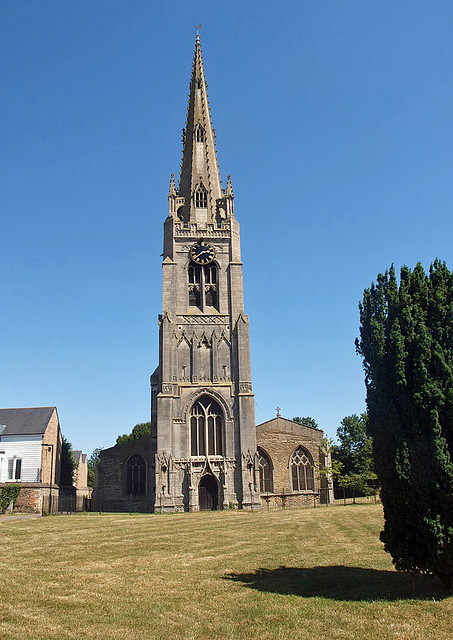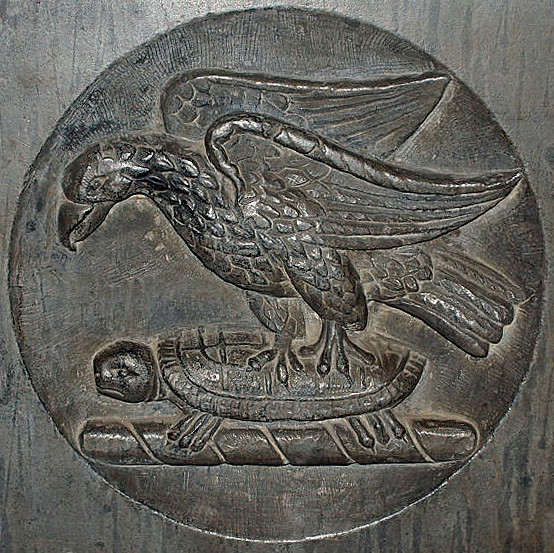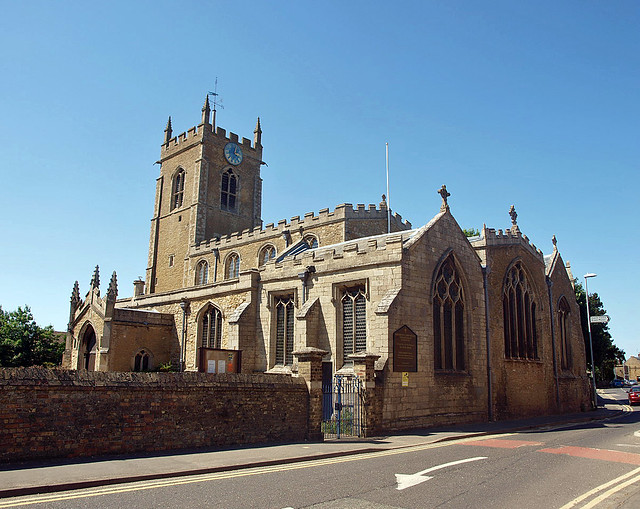St Mary is externally exceptional, despite the dire churchyard setting, and massive - the tower is a thing of extraordinary elegance - but internally disappointing. There's plenty of interest inside [I particularly liked the abundant use of gold paint and the ott reredos] but overall its an aseptic interior.
St Andrew is a sandstone delight, and much more intimate than its neighbour. A shame it was locked.
ST MARY. One of the most splendid spires of Cambridgeshire, rather in a Northamptonshire style (cf. Oundle, Kettering). Built about the middle of the C15, and in every detail clearly as expensively as possible. It is ashlar-faced and has big clasping buttresses. Quatrefoil frieze along the base. The W door has a steep concave gable and little miniature buttresses to the l. and r. The W window is big and wide. On the N and S sides are tall blank arcades. That motif is repeated higher up. The bell-openings are two two-light windows on each side, with a transome. The tower carries a crocketed spire connected with the tower by flying buttresses struck across to the pinnacles on the corners of the tower. The three tiers of dormer windows have straight-sided triangular heads. Inside, the tower arch is tall and has shafts with battlemented capitals and, as it were, intermediate capitals. High up inside the tower is a tierceron vault with a wide central circular opening for the bell ropes. But the tower was amongst the latest additions to the church. Its earliest parts have to be looked for on the N side of the nave. The arcade here, and also probably the chancel arch, date from after a fire of 1244. The arcade has circular piers with moulded capitals and arches with two hollow-chamfered mouldings. The chancel arch is simply double-chamfered and rests on shafts with moulded capitals. The details make one doubt whether they do not belong to the next phase in the history of the church, that responsible for the N aisle and most of the chancel, cf. the intersected tracery of the aisle E window (renewed by Scott in 1862), typical of c. 1300, and the arches from the chancel into the N and S chapels. The W window of the N aisle is Perp. The S aisle and S chapel followed in the first half of the C14: Dec windows with reticulated or flowing tracery (E windows renewed by Scott). The S arcade has thin hexagonal piers continued straight above the capitals and dying into the arches. The S doorway also is a typical piece of Dec design, with a tall pointed trefoiled head. The contemporary S porch consists of two rib-vaulted bays. Finally, to return to the time when the tower was built, in the C15 a lengthening of the chancel was found necessary. It was carried out with ashlar-facing, a five-light E window, niches to its l. and r., and niches also in the diagonal buttresses. - ROOD SCREEN. The dado only is preserved, by the tower arch. - STAINED GLASS. Much of time of the restoration. - PLATE. Two Chalices of 1731 ; two Patens and Flagon of 1765. - MONUMENTS. Many minor tablets of the C17 to C19, the only notable one Sir Harry Smith (of Harrysmith and Ladysmith; a native of Whittlesey) with bust, by G. G. Adams, 1862.
ST ANDREW. The church was appropriated to the Precentor of Ely by Bishop Nigel (1133-69) to increase the funds for the writing or acquiring of books. Of that time, however, nothing remains, and the church now is essentially Dec. In the S aisle one late C13 window with bar tracery. C14 the E window of five lights, the chancel chapel windows, the N aisle windows. Perp the arcades and the W tower. The arcade piers are thin with four shafts and four hollows and carry double-chamfered two-centred arches. The clerestory belongs to the same period. The W tower can hardly be earlier than the C16. It opens into the nave in a tall panelled arch. It has clasping buttresses, a W door with big flat leaves in the spandrels, a W window of three lights with intersected tracery in the depressed head, two-light bell-openings with transoms, gargoyles, battlements, and small pinnacles. Probably of the same date as the tower is the S porch. Chancel, chancel chapels and nave have original roofs, those of the chapels being no doubt the oldest. - PLATE. Chalice of 1560; Paten of 1632; Flagon, Paten, and Spoon of 1762; Chalice of 1772.
WHITTLESEY. Willows fringe the road that brings us to this northerly isle of the fens, the River Nene flows slowly past, and wild fowl settle among the rushes and the low pastures of Whittlesey Wash. It has been a market town for seven centuries and its market house is still in the middle of the square. It is an ordinary little town, flanked by the tall chimneys of brickyards rising in mass formation, but the bells ring out melodiously across the fens calling us to one of the loveliest steeples in the county. It is the tower of St Mary’s, raised in the 15th century, and beautiful with fine windows, panelled walls, and a doorway worthy of a small cathedral. Its splendid arch and its lofty vaulted roof rise up to panelled battlements with pinnacles from which spring flying buttresses to support the soaring spire.
The church comes from the three great building centuries, the chancel arch and the north arcade of the nave from the 13th, the chancel and the south arcade from the 15th, and the rest of the old work mostly from the 14th. The oak altar and the reredos are in memory of our heroes, one who died near Ypres, and those who came home safe. In a modern window glowing richly with purple, green, and gold, are three English saints, Edmund with the arrow of his martyrdom, Etheldreda with a model of Ely Cathedral, and Guthlac with the scourge. There is a bust of General Wakelyn Smith, a surgeon’s son who sleeps in the cemetery here, having fought at Waterloo and lived to be Governor of the Cape in 1847.
Whittlesey has another medieval church, St Andrew’s, with an imposing exterior and a fine tower. Slender pillars support the old nave arches, and there are grotesque corbels under the open timber roof. On each side of the 15th century arch are quaint figures of a man and a woman. The oak altar has a stone supported by four angels against a background.carved like richly patterned brocade, and another angel is holding the lectern desk on the tips of the wings and fingers. The oak pulpit with a figure of the Good Shepherd is in memory of a soldier who fell in France.
Here was born a boy who became Archbishop of Canterbury in 1368. It is thought that the pope desired a mild archbishop and chose William Whittlesey, who settled down in the old Bishop’s Palace at Otford in Kent and lived quietly there, but was tempted one day, by the pressure of heavy taxation of the clergy, to make his way slowly to London and protest from the pulpit of St Paul’s. He walked into the pulpit but had only just begun his sermon when he swooned and fell into the arms of his chaplain, and was carried out of the cathedral, put into a boat and rowed down to Larnbeth Palace, where he lingered for a few months and died.
The church comes from the three great building centuries, the chancel arch and the north arcade of the nave from the 13th, the chancel and the south arcade from the 15th, and the rest of the old work mostly from the 14th. The oak altar and the reredos are in memory of our heroes, one who died near Ypres, and those who came home safe. In a modern window glowing richly with purple, green, and gold, are three English saints, Edmund with the arrow of his martyrdom, Etheldreda with a model of Ely Cathedral, and Guthlac with the scourge. There is a bust of General Wakelyn Smith, a surgeon’s son who sleeps in the cemetery here, having fought at Waterloo and lived to be Governor of the Cape in 1847.
Whittlesey has another medieval church, St Andrew’s, with an imposing exterior and a fine tower. Slender pillars support the old nave arches, and there are grotesque corbels under the open timber roof. On each side of the 15th century arch are quaint figures of a man and a woman. The oak altar has a stone supported by four angels against a background.carved like richly patterned brocade, and another angel is holding the lectern desk on the tips of the wings and fingers. The oak pulpit with a figure of the Good Shepherd is in memory of a soldier who fell in France.
Here was born a boy who became Archbishop of Canterbury in 1368. It is thought that the pope desired a mild archbishop and chose William Whittlesey, who settled down in the old Bishop’s Palace at Otford in Kent and lived quietly there, but was tempted one day, by the pressure of heavy taxation of the clergy, to make his way slowly to London and protest from the pulpit of St Paul’s. He walked into the pulpit but had only just begun his sermon when he swooned and fell into the arms of his chaplain, and was carried out of the cathedral, put into a boat and rowed down to Larnbeth Palace, where he lingered for a few months and died.



Trying to contact david.robarts for permission to use one of his great photos. Tried on Flickr but had no reply so far.
ReplyDelete